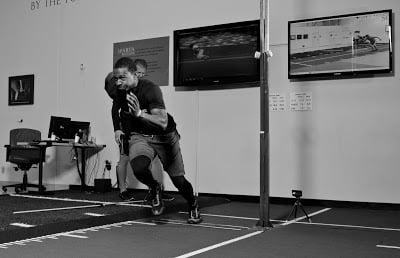
At Sparta, we train professional and high school athletes to improve their sprinting times, and one of the most difficult concepts for them to grasp is focusing less on trying to run fast. These athletes with a quicker turnover of their steps resemble cartoon characters, where the legs move really fast, but little forward progress is made.
The situation above describes stride rate, how quickly the legs turnover, and it is one of the major ways to run fast over longer distances. However, the best way to increase the start of your sprint, the most important part in running fast, is by taking longer strides. For example, we see most athletes taking 8-10 steps in a 10 yard run, but we want 7 steps at the most, regardless of their leg length.
There are two general avenues to improve stride length, hip flexibility and leg stability. By having more flexible hips, the athlete can get a greater knee drive to allow more distance with each stride. Increased stability, through improved leg strength, will enable the athlete to spend more time on each supporting leg for a further step forward. The most efficient way to attend to each of these aspects is by performing full range of motion resistance training, such as squats, because they concomitantly improve the stability aspect by strengthening the lower body.
Though we have previously talked about the dangers of static stretching prior to training (see Sparta Point 1/28/09), there are other stretching methods to increase flexibility in order to make stride length improvements. A recent study out of Northumbria University examined the effects of a more dynamic form of stretching, proprioceptive neuromuscular facilitation (PNF), on stride length and running speed. The PNF group showed a 9.1% improvement, meaning rather than taking 11 steps to get to a certain distance, an athlete would only need 10 steps.
So if you’re competing against our athletes, please continue to focus on stride rate and a quick leg turnover, as the appearance of running fast is much more important than your actual sprint time.